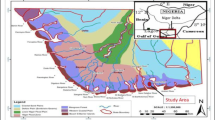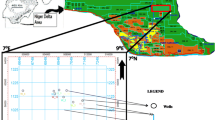Abstract
The discrimination of hydrocarbon (gas or oil) facies from non-hydrocarbon (wet sands) facies is an important goal in quantitative seismic interpretation and reservoir estimation. The differentiation of hydrocarbon facies from non-hydrocarbon in Mississauga Formation of early Cretaceous in Penobscot area is a difficult task due to smaller net pay thickness and shaly sand intervals. Based on seismic interpretation and wireline logs, five sand plays are identified in the middle of Mississauga Formation. Four sands have hydrocarbons while top of sand 5 represents hydrocarbon water transition zone. Among these four, the pay sand 4 is analyzed for hydrocarbon facies. Wireline logs and seismic data are used to derive various amplitude versus offset (AVO) based attributes such as: acoustic (I P ) and shear (I S ) impedances, Poisson ratio (σ) etc. Further, the combined attributes e.g., product of Lamé parameters (μ, λ) with density (ρ), their ratio (λ/μ), difference between bulk modulus (K) and shear modulus (μ), Δμρ/μρ, Δ(λ/μ + 2)(λ/μ + 2) and the pore space modulus (K P ) are also analyzed to find out the best attribute as a hydrocarbon facies discriminator from non-hydrocarbon facies in the shale imbedded pay sand 4 of Mississauga Formation. First, petrophysical parameters such as P and S wave impedances, Lamé’s parameters etc. are extracted from log data. Then, appropriate pairs of seismic attributes are crossplotted so that the hydrocarbon and non-hydrocarbon facies cluster together for quick identification and interpretation. Gamma ray index is crossplotted against spontaneous potential log to mark sand and shale facies. Fluid substitution modeling for various fluid types and saturation is also done which demonstrate that the cross-plots between different rock physics parameters can be used to distinguish between reservoir fluids. Our analysis reveals single P-wave based attributes are not sufficient to discriminate fluids thus the use of multi-attributes such as K P , λρ and K-μ is more effective to discriminate the hydrocarbon and non-hydrocarbon facies. The analysis of these cross-plots was done to map the reservoir sands and the hydrocarbon-water contact.
Similar content being viewed by others
References
Aki, K., and Richards, P.G., 1980, Quantitative seismology: theory and methods. W.H. Freeman, San Francisco, 700 p.
Avseth, P., Mukerji, T., and Mavko, G., 2005, Quantitative seismic interpretation: applying rock physics tools to reduce interpretation risk. Cambridge University Press, Cambridge, 371 p.
Batzle, M.L., Han, D.H., and Hofmann, R., 2001, Optimal hydrocarbon indicators. Annual International Meeting of Society of Exploration Geophysics (Expanded Abstract), San Antonio, Sep. 9–14, p. 1697–1700.
Berryman, J.G., Berge, P.A., and Bonner, B.P., 2002, Estimating rock porosity and fluid saturation using only seismic velocities. Geophysics, 67, 39–404.
Castagna, J.P., Swan, H.S., and Foster, D.J., 1998, Framework for the interpretation of AVO intercept and gradient. Geophysics, 63, 948–956.
Chen, T., Goodway, B., Zhang, W., Potocki, D., Calow, B., and Gray, D., 1998, Integrating geophysics, geology and petrophysics: a 3D seismic AVO and borehole/logging case study. 68th Annual International Meeting of Society of Exploration Geophysics (Expanded Abstracts), New Orleans, Sep. 13–18, 615–618.
Connolly, P., 1999, Elastic Impedance. The Leading Edge, 18, 438–452.
Fatti, J.L., Vail, P.J., Smith, G.C., Strauss, P.J., and Levitt, P.R., 1994, Detection of gas in sandstone reservoirs using AVO analysis: A 3-D seismic case history using the geostack technique. Geophysics, 59, 1362–1376.
Gassmann, F., 1951, Uber die Elastizitat poroser Medien, Vierteljahrsschrift der Naturforschenden Gesellschaft in Zurich, 96, 1–23.
Goodway, W., 2001, AVO and Lamé constants for rock parameterization and fluid detection. Recorder, 26, 39–60.
Goodway, W., Chen, T., and Downton, J., 1997, Improved AVO fluid detection and lithology discrimination using Lamé petrophysical Parameters; “Lambda-Rho”, “Mu-Rho”, & “Lambda/Mu fluid stack”, from P and S inversions. 67th Annual International Meeting of Society of Exploration Geophysics (Expanded Abstracts), Dallas, Nov. 2–7 p. 183–186.
Gray, D., Goodway, W., and Chen, T., 1999, Bridging the gap: Using AVO to detect changes in fundamental elastic constants. Annual International Meeting of Society of Exploration Geophysics (Expanded Abstracts), Houston, Oct. 31–Nov. 5, p. 852–855.
Hedlin, K., 2000, Pore space modulus and extraction using AVO. 70th Annual International Meeting of Society of Exploration Geophysics (Expanded Abstracts), Calgary, Aug. 6–11, p. 170–173.
Hilterman, F.J., 1989, Is AVO the seismic signature of rock properties? 59th Annual International Meeting of Society of Exploration Geophysics (Expanded Abstract), Dallas, Oct. 29–Nov. 2, p. 559.
Hilterman, F.J., 2001, Seismic amplitude interpretation. SEG/EAGE distinguished instructor short course, 247 p.
Hilterman, F.J., Schuyver, C.V., and Sbar, M., 2001, AVO examples of long-offset 2-D data in the Gulf of Mexico. The Leading Edge, 19, 1200–1203.
Khalid, P., 2011, Effects on seismic properties of thermoelastic relaxation and liquid/vapor phase transition. Ph.D. thesis, University of Pau, France, 124 p.
Khalid, P. and Ghazi, S., 2013, Discrimination of fizz water and gas reservoir by AVO analysis: a modified approach. Acta Geodaetica et Geophysica, 48, 347–361.
Kidston, A.G., Brown, D.E., Smith, B.M., and Altheim, B., 2005, The Upper Jurassic Abenaki Formation Offshore Nova Scotia: A Seismic and Geologic Perspective. Report Canada-Nova Scotia, Offshore Petroleum Board, 10 p.
Chopra, S. and Marfurt, K.J., 2005, Seismic attributes — A historical perspective. Geophysics, 70, 3SO–28SO.
Pengyuan, S., Xiuli, L., Yanpeng, L., Yuanyuan, Y., and Haifeng, C., 2008, Elastic parameter AVO approximation and their applications. Annual International Meeting of Society of Exploration Geophysics (Abstract), Las Vegas, Nov. 9–14, p. 523–527.
Quakenbush, M., Shang, B., and Tuttle, C., 2006, Poisson Impedance. The Leading Edge, 25, 128–138.
Russell, B.H., Hedlin, K., Hilterman, F.J., and Lines, L.R., 2003, Fluid-property discrimination with AVO: A Biot-Gassmann perspective. Geophysics, 68, 29–39.
Shuey, R.T., 1985, A simplification of the Zoeppritz equations. Geophysics 50, 609–614.
Smith, G.C. and Gidlow, P.M., 1987, Weighted stacking for rock property estimation and detection of gas. Geophysical Prospecting, 35, 993–1014.
Wade, J.A. and Maclean, B.C., 1990, The geology of the southeastern margin of Canada. In: Keenand, M.J. and Williams, G.L. (eds.), Geology of North America. Geological Society of America, Boulder, p. 167–238.
Welsink, H.J., Dwyer, J.D., and Knight, R.J., 1990, Tectono-Stratigraphy of Passive Margin Off Nova Scotia. In: Tankard, A.J. and Balkwill, J.R. (eds.), Extensional Tectonics and Stratigraphy of the North Atlantic Margins. American Association of Petroleum Geologists, Memoir 46, 215–231.
White, R.E., 2000, Fluid detection from AVO inversion: the effects of noise and choice of parameter. 62nd EAGE meeting (Abstract), Glasgow, May 29–June 2, p. 1–5.
Zoeppritz, K., 1919, Erdbebenwellen VIIIB, On the reflection and propagation of seismic waves. Göttinger Nachrichten, I, 66–84.
Author information
Authors and Affiliations
Corresponding author
Rights and permissions
About this article
Cite this article
Khalid, P., Ahmed, N., Khan, K.A. et al. AVO-derived attributes to differentiate reservoir facies from non-reservoirs facies and fluid discrimination in Penobscot area, Nova Scotia. Geosci J 19, 471–480 (2015). https://doi.org/10.1007/s12303-014-0048-0
Received:
Accepted:
Published:
Issue Date:
DOI: https://doi.org/10.1007/s12303-014-0048-0




